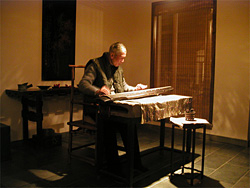Feature Contents
Some random notes for my daughters - on enjoying paintings | back to feature home | |
| Once, when somehow obliged to examine a new painting of mine, my father-in-law―an honest and sensitive man who had traded wholesale in rice and clocks―admitted I'd put him off-balance, saying simply 'I don't understand how to enjoy this.' I had the impression that he was uncertain how to take the measure of my preoccupation. Like other ways of passing time, savouring an artwork is the consequence of mood, company and temperament. One does what one can by attending to circumstances and concocting associations of thought and feeling that provide a foothold here or there. Chinese literature is full of considerations of this kind. Reading proscribed books in the safety of a snowbound retreat features in a discussion of how to read pleasurably. A laconic list of 'what pleases and displeases flowers' records the satisfactions and discomforts that come when cut flowers are set among noises, flavours, and the distractions or attractions of sundry visitors. Prose and paintings describe occasions of showing art to one's friends at well-chosen times of the year. Frequently the setting is a garden at the peak of a season, with elegant furniture brought outdoors. Music is played and incense, remarkable stones and comely plants in exquisite pots are set up on side tables while servants arrange small dishes and prepare tea. Other servants bring out objects and paintings. Still more servants hold aloft a hanging scroll, while the gentry stroke their beards and appreciate the charms they've arranged for themselves. hahah If you were to trace the elements in these scenes you would discover voluminous catalogues on the connoisseurship of stones, incense and music. Of the music, that which most aptly accompanies the viewing of elegant things is played on the qin. This long, stringed instrument, is typically placed on a narrow hardwood table or atop a hollow ceramic base that assists its reverberations (most evocatively, the ceramic might be an ancient hollow brick displaying the primitive designs of the early dynasties). These days the successor of the qin finds its way into 'Chinese orchestras' played for large audiences, but it is firstly a solo instrument, played in intimate surroundings. Old qin music is emotionally subtle and to the modern ear it is unpredictable in structure and yet the succession of sounds is incredibly pure. Performances may be praised for the delicacy of the shapes of silence between the notes. Unless you are fortunate in your friendships, you will have to be satisfied with recordings by twentieth century virtuosos. An oft-repeated image of the qin is that of TAO Yuanming 陶淵明 (365-427), who praised a string-less qin, suggesting that the potential music (or exquisite silences) of such an instrument were even more refined than the stringed versions. Similarly, other writers praised the writing of descriptions of imagined gardens as even more satisfying than records of those that happened to exist. |  | |
 |